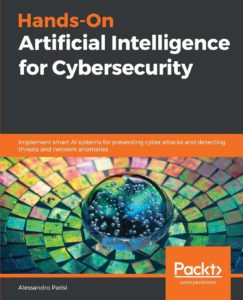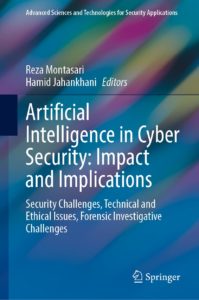5 artificial intelligence in cyber security books and [Free PDF]. Artificial intelligence (AI) is increasingly becoming a vital tool in cybersecurity, offering smart systems for threat detection and prevention. The promise of huge AI productivity gains pushes businesses to adopt it. However, the practical implementation of AI in daily cybersecurity operations often remains a challenge.

Below you find books on how AI can be effectively applied in various cybersecurity domains, the importance of evaluating AI algorithms, and the technical requirements for integrating AI into your security strategy.
Key points in these artificial intelligence in cyber security books
- AI’s role in cybersecurity is expanding, covering areas like email threat detection and network anomalies.
- Testing and evaluation of AI algorithms are crucial for maintaining robust cybersecurity measures.
- Advanced topics like Generative Adversarial Networks (GANs) are becoming increasingly relevant in cybersecurity.
- Explainability in AI models is essential, especially in security contexts where decision rationale needs to be clear.
- Ethical and legal considerations, such as data privacy and legal liability, are gaining importance as AI integrates more into security solutions.
- Adversarial attacks against AI models are a growing concern, requiring more robust and resilient systems.
- Quantum computing and post-quantum signatures are emerging topics that could impact the future of cryptographic systems.

Hands-On Artificial Intelligence for Cybersecurity
 Implement smart AI systems for preventing cyberattacks and detecting threats and network anomalies
Implement smart AI systems for preventing cyberattacks and detecting threats and network anomalies
The book “Hands-On Artificial Intelligence for Cybersecurity” by Alessandro Parisi is a practical guide that goes beyond theory. It offers code snippets and real-world examples, making it easier to implement AI-driven security measures. This hands-on approach is invaluable for cybersecurity professionals who want to apply AI in their daily operations.
Comprehensive Coverage
The book covers a broad spectrum of AI applications in cybersecurity, from email threat detection to network anomaly identification. It even dives into advanced topics like Generative Adversarial Networks (GANs). This comprehensive coverage makes it a one-stop resource for understanding how AI can be employed in various cybersecurity domains.
Evaluation and Testing
A unique aspect of this book is its focus on evaluating the effectiveness of AI algorithms. It guides you through the process of testing your AI models, a crucial step often overlooked. This ensures that your AI-driven security measures remain robust and up to date, given the ever-changing landscape of cyber threats.
Technical Requirements
While the book is packed with valuable insights, it assumes you have a basic understanding of Python programming and cybersecurity concepts. If you’re not familiar with these, you might find some sections challenging. However, the language is accessible enough for a high school graduate with interest in the field.
Overall, this book is a must-read for cybersecurity professionals looking to integrate AI into their security strategy. It offers actionable insights and practical examples, making it a solid investment for those aiming to enhance their cybersecurity posture through AI. Here you can get hands-on artificial intelligence for cybersecurity PDF details.
Artificial Intelligence in Cyber Security: Theories and Applications
 Editors: Mark Stamp, Corrado Aaron Visaggio, Francesco Mercaldo, Fabio Di Troia
Editors: Mark Stamp, Corrado Aaron Visaggio, Francesco Mercaldo, Fabio Di Troia
Explainability and transparency: “Artificial Intelligence for Cybersecurity” by Mark Stamp and colleagues go into the opaque nature of AI models, emphasizing the need for explainable AI in cybersecurity. The book argues that black-box models are a liability in security contexts, where understanding the reasoning behind decisions is crucial. This focus on explainability is a key takeaway for professionals concerned about the risks of deploying AI in security operations.
Adversarial Attacks and Robustness
The book also tackles the issue of adversarial attacks against AI models, a topic of growing concern in the cybersecurity community. It explores how these attacks can manipulate AI systems, making the case for more robust, resilient models. This is particularly relevant for those looking to safeguard their AI implementations against sophisticated threats.
Diverse Security Domains
The book doesn’t limit itself to one aspect of cybersecurity. It covers a range of security domains including malware, biometrics, and side-channel attacks. This comprehensive view is beneficial for professionals who need a broad understanding of how AI impacts different facets of cybersecurity.
Technical Depth with Accessibility
The authors have managed to strike a balance between technical depth and accessibility. While the book is detailed enough for seasoned professionals, the language is straightforward, making it understandable for high school graduates interested in cybersecurity. However, some prior knowledge of AI and cybersecurity concepts will enhance comprehension.
Overall, “Artificial Intelligence for Cybersecurity” is a valuable resource for both researchers and practitioners. It offers a nuanced look at the challenges and opportunities of using AI in cybersecurity, making it a must-read for anyone in the field looking to explore this intersection. The book provides actionable insights that can guide the development of more secure and transparent AI-driven security systems.
Artificial Intelligence in Cyber Security
 Impact and Implications: Security Challenges, Technical and Ethical Issues, Forensic Investigative, Technologies for Security Applications by Reza Montasari (Editor), Hamid Jahankhani (Editor)
Impact and Implications: Security Challenges, Technical and Ethical Issues, Forensic Investigative, Technologies for Security Applications by Reza Montasari (Editor), Hamid Jahankhani (Editor)
Ethical and legal challenges: “Artificial Intelligence in Cyber Security: Impact and Implications” dives deep into the ethical and legal aspects of AI in cybersecurity. The book doesn’t just stop at the technicalities; it goes further to explore the moral and legal dilemmas that come with the use of AI. This is crucial for professionals who need to consider the broader implications of deploying AI in security solutions.
Adversarial AI and Future Threats
The book also covers the adversarial use of AI, detailing how it can be weaponized for malicious purposes. It even goes a step further to forecast potential future attacks that could be executed using AI. This foresight is invaluable for cybersecurity experts who are tasked with preparing for emerging threats.
Comprehensive Coverage
The book offers a well-rounded view of AI in cybersecurity, touching on everything from technical challenges to ethical concerns. It’s not just a theoretical text; it blends research findings with practical methods, making it a useful guide for both academics and practitioners.
Expert Contributions
Each chapter is penned by an expert in the field, whether from law enforcement, academia, or industry. This lends credibility to the book and ensures that the content is both reliable and grounded in real-world experience.
Who Should Read It?
While the book is an advanced text aimed at researchers and postgraduate students, its comprehensive coverage makes it a valuable resource for anyone in the cybersecurity field. Whether you’re a seasoned expert or a high school graduate with a keen interest in cybersecurity, this book offers insights that can help you understand the complex landscape of AI in cybersecurity.
Cybersecurity and Artificial Intelligence [Free PDF]
 Threats and Opportunities by Steve Wilson (CPO, Contrast Security) – with help from various AI technologies by Steve Wilson
Threats and Opportunities by Steve Wilson (CPO, Contrast Security) – with help from various AI technologies by Steve Wilson
AI’s role in cybersecurity: “Cybersecurity and Artificial Intelligence: Threats and Opportunities” by Steve Wilson offers a comprehensive look at how AI is shaping the cybersecurity landscape. The book go into both the offensive and defensive roles of AI, providing a balanced view. It’s a must-read for understanding how AI technologies like machine learning can be leveraged for better security but also how they can be weaponized for more sophisticated attacks.
Emerging Threats
The book covers emerging threats like AI-assisted phishing and machine learning-powered malware. It’s not just about understanding these threats but also about preparing for them. The book provides actionable insights into how to defend against these AI-driven threats, making it a practical guide for cybersecurity professionals.
Cutting-edge Technologies
The book introduces cutting-edge application security (AppSec) technologies like Interactive Application Security Testing (IAST) and Runtime Application Self-Protection (RASP). These are crucial for anyone involved in application development and security, offering modern solutions for modern problems.
Ethical and Legal Implications
The book doesn’t shy away from the ethical and legal considerations of using AI in cybersecurity. Topics like data privacy, transparency, and legal liability are covered, which are increasingly important as AI systems become more integrated into security solutions.
Who Should Read It?
This book is not just for cybersecurity professionals. Its clear and accessible language makes it suitable for anyone interested in the intersection of AI and cybersecurity. Whether you’re an IT professional, a developer, or just someone interested in tech, this book equips you with the tools and insights needed to understand and navigate the complex landscape of AI in cybersecurity.
Artificial Intelligence and Cybersecurity
 Advances and Innovations edited By Ishaani Priyadarshini, Rohit Sharma
Advances and Innovations edited By Ishaani Priyadarshini, Rohit Sharma
AI in cybersecurity context: “Artificial Intelligence and Cybersecurity: Advances and Innovations” is a comprehensive resource that goes into the intersection of AI and cybersecurity. The book is particularly useful for professionals looking to understand how AI can be leveraged to enhance security measures. It covers a range of topics from smart cities to Internet of Things (IoT), providing both a high-level overview and in-depth technical insights.
Diverse Topics
The book is unique in its coverage of a wide array of subjects. Chapters on heart disease prediction and photonic crystal sensing for tumor detection may seem out of place in a cybersecurity book, but they offer a broader perspective on the capabilities of AI. For cybersecurity professionals, chapters focusing on IoT security, blockchain, and risk management are directly relevant and offer actionable insights.
Practical Applications
The book doesn’t just stop at theory; it goes into practical applications. For instance, it discusses cybersecurity solutions for Industry 4.0 and IoT, which are critical in today’s interconnected world. It also covers emerging technologies like blockchain, which has potential applications in secure transactions and data integrity.
Interdisciplinary Approach
The book serves as an interdisciplinary platform, making it a valuable resource not just for cybersecurity professionals but also for researchers and educators. It bridges the gap between AI and cybersecurity, providing a holistic view that is often missing in other literature. This makes it a good pick for those looking to expand their knowledge beyond their immediate field.
Who Should Read It
Given its broad scope and technical depth, this book is ideal for a wide audience. Whether you’re a cybersecurity veteran, a researcher in AI, or even a student looking to enter these fields, this book offers something of value. It’s written in a way that balances technical jargon with readability, making it accessible yet detailed.
Cyber Security Using Modern Technologies
 Artificial Intelligence, Blockchain and Quantum Cryptography edited By Om Pal, Vinod Kumar, Rijwan Khan, Bashir Alam, Mansaf Alam
Artificial Intelligence, Blockchain and Quantum Cryptography edited By Om Pal, Vinod Kumar, Rijwan Khan, Bashir Alam, Mansaf Alam
Cutting-edge technologies in focus: “Cyber Security Using Modern Technologies” is a comprehensive guide that goes into the application of Artificial Intelligence, Quantum Cryptography, and Blockchain in cybersecurity. The book is a treasure trove for cybersecurity professionals keen on understanding how these emerging technologies can be leveraged for enhanced security measures. It starts with an introduction to Quantum Computing and goes on to cover a wide array of topics, including network forensics and intrusion detection using machine learning.
Quantum Computing and Post-Quantum Signatures
The initial chapters focus on Quantum Computing and its implications for cybersecurity, including Post-Quantum Digital Signatures. This is crucial for professionals who are concerned about the future-proofing of cryptographic systems against quantum attacks. The book provides both theoretical and experimental validation for the protocols discussed, adding credibility to its content.
AI and Machine Learning Applications
The book also goes into the application of Artificial Intelligence and machine learning in cybersecurity. Topics like intrusion detection using machine learning are of high relevance in the current threat landscape. The book offers new techniques to handle modern threats intelligently, making it a must-read for those looking to incorporate AI-driven security solutions.
Blockchain and Network Security
Blockchain’s application in securing advanced metering infrastructure in smart grids is another highlight. The book provides a detailed analysis of how blockchain can be used to enhance security, especially in centralized environments. This is particularly useful for professionals working on IoT and smart grid security.
Who Should Read It?
The book is written in a clear and comprehensive manner, making it accessible to a wide audience. Whether you’re a seasoned cybersecurity professional, a researcher, or a graduate student, this book offers valuable insights into the future of cybersecurity. It successfully bridges the gap between academic research and practical application, making it a reliable resource for anyone looking to bolster their cybersecurity measures.
Working with the complexities of AI in cybersecurity
Reading these artificial intelligence in cyber security books provides a comprehensive understanding of the multifaceted role AI plays in cybersecurity. They offer not just theoretical knowledge but also practical tools and techniques, making them invaluable resources for professionals in the field.
Also make sure to check out Hands-On Artificial Intelligence for Banking.
From ethical considerations and the importance of AI explainability to preparing for adversarial attacks against AI systems, these books cover it all. Whether you’re an experienced cybersecurity professional or just starting out, these books equip you with the knowledge you need to effectively integrate AI into your cybersecurity efforts.

